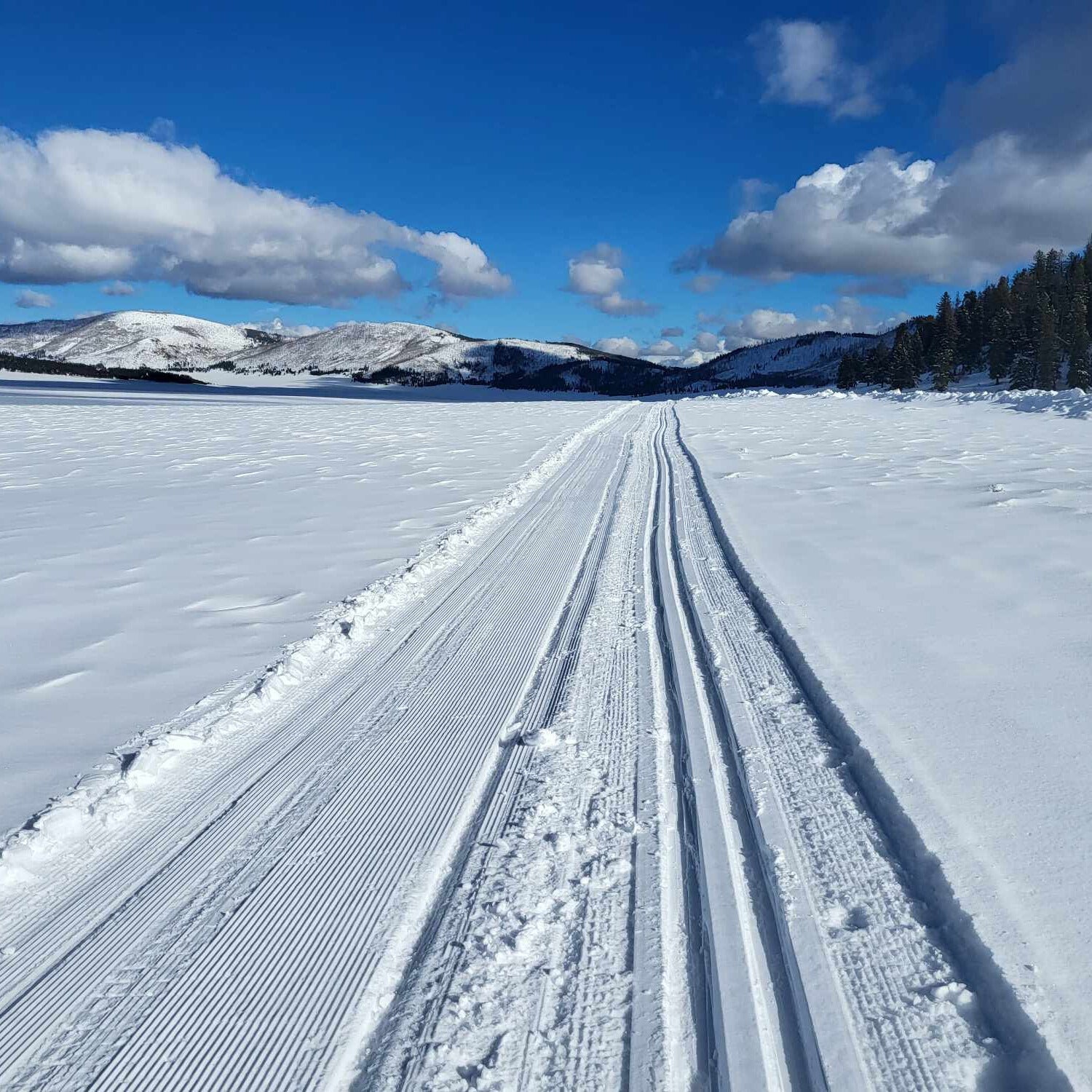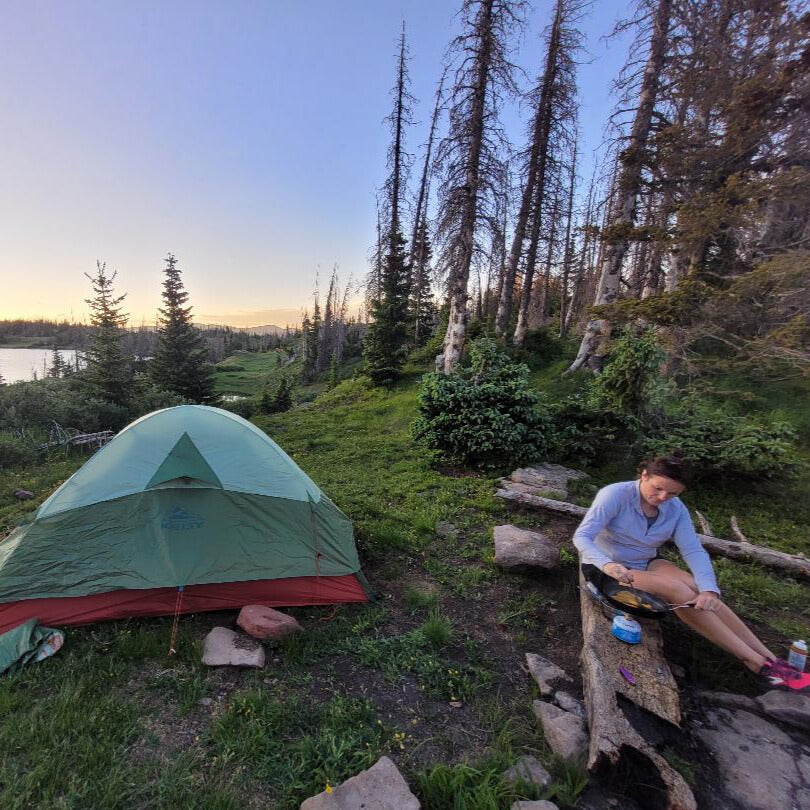Your Cart is Empty
21 FEB SKIING THE SAN JUANS PART TWO: CLOTHING
This is Part II of II; click here to read Part I. In this post, I’ll dive into what I wear for ski touring in the San Juan backcountry, and explain how you can build a kit of clothing layers that work together to maximize functionality while minimizing weight.
Outer layers for ski touring fall into two broad categories: hardshell and softshell. Hardshells are water- and wind-proof layers designed for the harshest mountain weather. Quality hardshells use waterproof breathable fabrics, like GoreTex or eVent, which allow some moisture to escape while keeping the weather out. Even the best waterproof breathable fabric, however, is still going to make you feel clammy and sticky if you are working hard. For all but the worst conditions, a quality softshell provides plenty of protection with significantly more breathability.
Hardshell or Softshell?
Just like with my backpack, I like to have two clothing systems to choose between, depending on the day. For the majority of ski touring, I wear softshell outer layers on the top and bottom. Softshells allow heat and moisture to escape, which prevents sweat buildup and actually keeps you warmer in the long run. Even when it is snowing a little bit, a good softshell will keep you dry as long as it remains below freezing. I only switch to hardshells on big storm days when it is truly dumping snow. A good DWR (durable water repellent) treatment also helps keep you dry. If the DWR treatment on your jacket has worn off, you can refresh it with Nikwax. I prefer the wash-in treatments, like Softshell Proof and TX Direct.
You can also mix-and-match. For avalanche education or snow study days, I like to wear hardshell pants that will keep me dry kneeling in a snowpit, but I usually still wear a soft-shell layer on the top. If I could only have one pair of ski touring outer layers, I would pick hardshell pants and a softshell jacket.

A good ski touring jacket will be lightweight with a good range of motion, and sized large enough to fit over all of your other layers. I prefer an un-insulated shell jacket for ski touring, as this gives me more layering flexibility. Remember that you’ll generally be a lot warmer skiing in the backcountry than you would be skiing at a resort.
Important features to look for in ski touring pants are a good range of motion, quality built-in gaiters (the elastic inner ‘cuff’ that goes over your boot) to keep out snow, and durable patches on the inner ankles to protect against abrasion from crampons and ski edges. Another nice bonus feature is a beacon pocket. I like to wear my avalanche beacon in my pocket, and I love my Black Diamond Mission pants, which have a special harness in the right pocket designed to hold a beacon. You also need to be wearing a sturdy belt if you choose to pocket carry. If your pants don’t have a dedicated beacon pocket, you should carry your beacon in a chest harness.

Base Layers
For ski touring, it’s all about layering, and a good base layer is essential. I run pretty warm, so I wear silkweight long underwear bottoms on all but the coldest days. Most new backcountry skiers are surprised at how much heat they generate when ski touring. Anything thicker than a midweight long underwear bottom will be overkill for the majority of Colorado backcountry skiing.
For my upper body base layer, I prefer a hooded long sleeve shirt. I find myself touring uphill in just my baselayer quite often, and a hood keeps the sun off my neck and provides just the right amount of extra warmth for moving uphill when the sun is bright and temperatures are in the 20’s, super common conditions here in the San Juan mountains.

The most important thing to look for when choosing base layers is a quality, non-cotton, fabric. Merino wool is the absolute best material for base layers, but it can be super expensive. Synthetic options (polyester etc.) perform almost as well for a fraction of the price. As long as you avoid cotton or cotton-blend fabrics, you’ll be just fine.
Insulation
I typically bring at least two insulating coats when backcountry skiing: one big ‘puffy’ coat, and one or two thinner active insulation layers.
The puffy coat stays at the bottom of my pack the majority of the time. On an average tour, I might only wear it for twenty or thirty minutes while eating lunch. But it is important to have a big insulating layer in case somebody gets injured or has equipment issues and we get stuck out later than expected. The Black Diamond Cold Forge is what I’m currently using, but there are a ton of options for big puffy coats from every major outdoor apparel brand, and you can easily save quite a bit here by carrying a cheaper (but heavier) puffy jacket.
The active insulation gets a lot more use throughout the day. I typically wear a thin fleece jacket directly on top of my base layer. I like a pullover jacket with a hood, like the Patagonia R1 Hoody, but there are a lot of good options for thin fleece layers. Just like your base layer, quality material is the most important factor. A highly breathable wool or premium synthetic (Polartec etc.) can make a big difference in comfort throughout the day.
Another good option for colder days is a hybrid style jacket with ‘mapped’ insulation. These layers have less insulation on the sleeves and back, and more insulation on the front of the torso. The Black Diamond First Light Hybrid Hoodie is my go-to hybrid insulating layer. I can’t skin uphill in most insulating ‘puffy’ layers because my back gets sweaty, but a hybrid jacket solves this problem. There are good options on the market from all of the major outdoor apparel brands: Patagonia, The North Face, etc.
Finally, I usually bring an insulated vest to add some extra warmth. I like vests because they keep you warm where it matters most, your core, while still allowing heat and moisture to escape from the underarm.
My ‘action suit’, or the set of layers that I wear the majority of the time while ski touring, consists of a long-sleeve hooded base layer, a lightweight active insulation piece (a fleece or hybrid hoody, depending on conditions), and a softshell jacket. I’ll sometimes take off the shell on the way up if it isn’t windy, and I’ll strip all the way down to the base layer on warmer days. When it’s extra blustery for the descent I’ll cinch up the hood and toss an insulated vest over the softshell.
Accessories
A lightweight neck gaiter (Buff or similar) is an excellent accessory piece for almost any conditions. On cold days it’s a great extra layer that’s easy to take on and off without removing your backpack. In warmer conditions, it makes a great sunglasses wipe.

I also like to wear a baseball cap for ski touring. I usually bring a warm beanie hat in my backpack, but it plays a similar role to my big puffy coat: it’s something that I only put on when digging a pit, eating lunch, or in an emergency. Most of the time while backcountry skiing, an insulated beanie is way too warm. A baseball cap provides some protection from the sun while allowing heat to escape. When it’s a little chillier, I’ll use my Buff like a headband to keep my ears warm, on top of the baseball cap.
I typically bring two pairs of gloves on a ski tour: one heavier pair for working in pits or skiing down in cold weather, and a lighter pair for skinning uphill. I’m a big fan of a gauntlet style glove for the warmer pair; my current pick is the Outdoor Research Revolution gloves, which strike a great balance between warmth, dexterity, and affordability. For skinning uphill I like a pair of gloves with more insulation on the back of the hand, and not much on the palm. There are several good options in this category; I like the Outdoor Research Ascendant Sensor glove for it’s incredible dexterity and touchscreen compatibility. If you’re on a tight budget, gloves are a good place to save some money. Insulated work gloves are more than adequate for all but the most extreme and adventurous ski touring, and cost a whole lot less than their ski-specific name-brand counterparts. Kinco makes a variety of excellent insulated work gloves that are fantastic for skiing. You’ll sacrifice some dexterity and weatherproofness, but for most skiers in most conditions it shouldn’t be a problem.
Good sunglasses are also super important. Look for a pair with wrap-around protection. The combination of bright sun from above and powerful UV radiation reflected off the snow can wreck your eyes if you don’t keep them protected. I like the Suncloud Range glasses, with the mirrored lens option, as a cheaper pick that can still outperform glasses from big names like Smith and Oakley.
ABOUT the AUTHOR
Carl is a guide and educator based in Southwest Colorado. He is happiest when pushing his comfort zone in wild places. More information about Carl is available at www.carlschnitker.com.




